

 | Phyton-International Journal of Experimental Botany |  |
DOI: 10.32604/phyton.2021.014082
ARTICLE
Anthocyanin Profiles in Grape Berry Skins of Different Species of Wine Grapes in Shanxi, China
1College of Food Science and Pharmaceutical Engineering, Zaozhuang University, Zaozhuang, 277160, China
2Pomology Institute, Shanxi Academy of Agricultural Science, Taiyuan, 030031, China
3College of Life Sciences, Zaozhuang University, Zaozhuang, 277160, China
*Corresponding Author: Qingliang Li. Email: liang85h@163.com
Received: 31 August 2020; Accepted: 06 November 2020
Abstract: To understand the anthocyanin characteristics of wine grape varieties, the anthocyanin composition and content of 31 wine grape varieties were analyzed to explore the use of anthocyanins as chemical fingerprints to distinguish varieties. Results showed that a total of 21 anthocyanins were detected in the skins, including cyanidin, delphinidin, petunidin, peonidin and malvidin 3-monoglucosides (or 3,5-diglucosides) along with the corresponding acetyl and p-coumaroyl derivatives. The highest and lowest total amount of anthocyanins were detected in ‘Ruby Cabernet’ and ‘Muscat Rouge’, respectively. In the 21 Vitis vinifera grapes, there were 3~11 monoglucoside anthocyanins detected, however, there were 4 to 9 monoglucoside anthocyanins and 1~7 diglucoside anthocyanins detected in the 10 other species of grapes. Except for ‘Zhesexiang’ ‘Seibel Noir’, ‘44-6-7-1’ and ‘Beibinghong’, the contents of diglucoside anthocyanins in the other six varieties accounted for more than 52% of the total anthocyanins. Except for ‘Zhesexiang’, ‘Muscat Rouge’ and ‘Beibinghong’, the content of methylated anthocyanins accounted for more than 75% of total anthocyanins. There were significant differences in the anthocyanin types and contents in the skins among V. vinifera and other grapes. The results of the principal component analysis and the cluster classification of 31 grape varieties (lines) were nearly consistent, which suggested that anthocyanins can be used as chemical fingerprints to distinguish wine grape varieties.
Keywords: Anthocyanin; cluster analysis; principal component analysis; wine grape
As the most important water-soluble pigments in plants, anthocyanins are widely found in the flowers and fruits of higher plants, which gives them different colors [1,2]. Grape is one of the most important fruit crops in the world, with a 2018 total surface of 7.4 million hectares and a production of 7.8 million tonnes, about 50% destined to wine production [3]. The anthocyanins in grape berry skin are one of the most important criteria to assess grape quality, especial the wine quality. The anthocyanins in grapes impart the color of red wines, which can also enter the wine from the peel through the process of pressing and fermentation [4]. The type and content of anthocyaniins not only play an important role in the color, flavor, taste but also contribute greatly to nutritional value of wine [5–7].
The anthocyanins in grapes are the glucoside forms of cyanidin (Cy), delphinidin (Dp), petunidin (Pt), peonidin (Pn), pelargonidin (Pg) and malvidin (Mv), along with the corresponding acetyl, p-coumaroyl, and caffeoyl derivatives in cultivars [8,9]. Varieties, environmental factors and agronomic measures all affect the anthocyanin content in grapes [5,10,11], but the proportions of individual anthocyanins are primarily determined by genotype, so the anthocyanin profiles can be used to distinguish red grapes and wines produced by different cultivars [12–14]. Liang et al. [5] analyzed the anthocyanin components of 110 grape varieties and found that the composition and content of anthocyanins in the grape skins of different species of the genus Vitis varies significantly. Vitis vinifera L. usually contains only mono-glucosides including Mv, Cy, Dp, Pn and Pt 3-monoglycosides with their corresponding acetyl, p-coumaroyl and caffeoyl derivates but no Pg anthocyanins [15]. Malvidin-3-O-glucoside is the chief anthocyanin in both grapes and wines of many European red vine varieties [16]. However, non- Vitis vinifera grape species, such as V. labrusca, V. rupestris and Chinese wild grape, contain 3,5-diglucosides and Pg-derived anthocyanins [5,17,18].
In this paper, 31 red wine grape varieties in Shanxi province of China were used as materials to determine the anthocyanin composition and content by high-performance liquid chromatography-mass spectrometry (HPLC-MS). The anthocyanin types in different grape varieties were compared. Cluster analysis and principal component analysis were carried out based on the anthocyanin content of each monomer to differentiate species by using anthocyanins as chemical fingerprints.
The fruits of 31 wine grape varieties were collected from Pomology Institute, Shanxi Academy of Agricultural Science, Taigu (Taigu) and the National Grape Germplasm Resources (Taigu) during the fruit ripening period from August to October in 2017. Each variety chose the same growth plants, three plants were 1 plot and three replicates, a total of nine plants. The fruits were sampled from the middle of dragon, and 4 clusters were randomly collected from each plot (considering the shaded and sunny side of the ear, 2 clusters on both sides of the fence, a total 12 clusters). After sampling, the fruits were taken back to the laboratory, all berries were mixed, then the skins were quickly peeled off with tweezers under 4°C, frozen in liquid nitrogen and stored at −80°C. The anthocyanins were extracted and analyzed in the laboratory from November to December in 2017. The names of the test materials and the sampling times are shown in Supplementary Tab. 1.
2.2 Detection of Anthocyanins in Grape Skin
The anthocyanins in the skins were extracted and detected according to the method of Liu et al. [19]. The grape skins stored at −80°C were ground into powder using liquid nitrogen. Then 1.000 g powder were extracted with 5 mL of 1% hydrochloric acid-methanol under 30°C for 2 h in the dark. The liquid extract and powdered grape skin were separated by centrifugation at 9 000 r·min−1 for 10 min at 4°C. The grape powder was re-extracted for 3 times, and the liquid extract were combined, rotated and evaporated at 35°C. Then the residue was diluted to 5 mL using chromatographic grade methanol and stored at −40°C for testing.
The HPLC-MS analyses were carried out using a WATERS ACQUITY UPLC-PDA detector. Chromatographic separation was carried out using a C18 column (100 mm × 2.1 mm i.d. 1.7 μm) and thermostated at 45°C. The mobile phase was a linear gradient of water/formic acid (98:2) (solvent B) in acetonitrile (solvent A), at a flow rate of 0.3 mL·min−1. The following elution gradient was used: 0–20 min, 6%–16% A; 20–28 min, 16%–23% A; 28–35 min, 23%–50% A; 35–37 min, 50% A; 37–40 min, 50%–60% A. Then the anthocyanins were identified using WATERS MALDI SYNAPT QTOF-MS. The operating parameters were: Capillary voltage, 3 000 V; cone voltage, 30.0 V; cone gas flow, 10 L·h−1; desolvation gas flow, 700 L·h−1; ion source temperature, 100°C; desolvation temperature, 400°C. The instrument was operated in a positive ion mode scanning from 50 to 2 000 m·z−1.
The anthocyanin contents were identified based on the HPLC-UV-MS fingerprint library of grape and wine anthocyanins [19]. The type of monomer anthocyanins was determined by using the full ion scanning spectrum of mass spectrometry through the quality spectrum analysis, retention time and comparative analysis of literature reports. The types of anthocyanin monomers detected in the grapes were shown in Supplementary Tab. 2. Anthocyanins were quantified using malvidin 3-O-glucoside as a standard according to Liu et al. [19].
The data were reported as the mean ± standard error (S.E.) of three replicates. Analysis of significant differences was performed using SPSS 17.0 data analysis software at p ≤ 0.05. Principal component analysis (PCA) and cluster analysis were performed to analyze the data for anthocyanins using SAS 8.0.
3.1 Anthocyanin Contents in Grape Skins of 31 Varieties
The total anthocyanin contents in the skins of 31 grape varieties were significantly different, ranging from 36.793 to 3995.079 mg·kg−1 FW (Tab. 1). The highest contents of anthocyanins were observed in the skins of ‘Ruby Cabernet’ and ‘Seibel Noir’, while those in ‘Beibinghong’, ‘Beihong’ and ‘44-6-7-1’ were significantly lower than them. The contents in grape skins of ‘Petit Verdot’ and ‘Malbec’ were significantly lower than that of ‘Beibinghong’, but there were no significant differences between them and ‘Beihong’, ‘44-6-7-1’. The contents of ‘Mei Yu’, ‘Petit Verdot’ and ‘Malbec’ were not significantly different. But they were significantly higher than those of ‘Merlot181’ and ‘Cabernet Gernischt’. The total contents of anthocyanins in ‘Cabernet Sauvignon 169’, ‘Marselan c980’, ‘Syrah 100’, ‘Tempranillo’ and ‘Areni’ were 50.9%~55.5% of that in ‘Ruby Cabernet’ and ‘Seibel Noir’; while the ones in ‘Muscat Rouge’ and ‘Zhesexiang’ were significantly lower than those in other varieties, only 0.8% to 2.7% of the total contents in ‘Ruby Cabernet’ and ‘Seibel Noir’.
Table 1: The contents of different types of anthocyanins in the skins of 31 grape varieties (mg·kg−1FW)

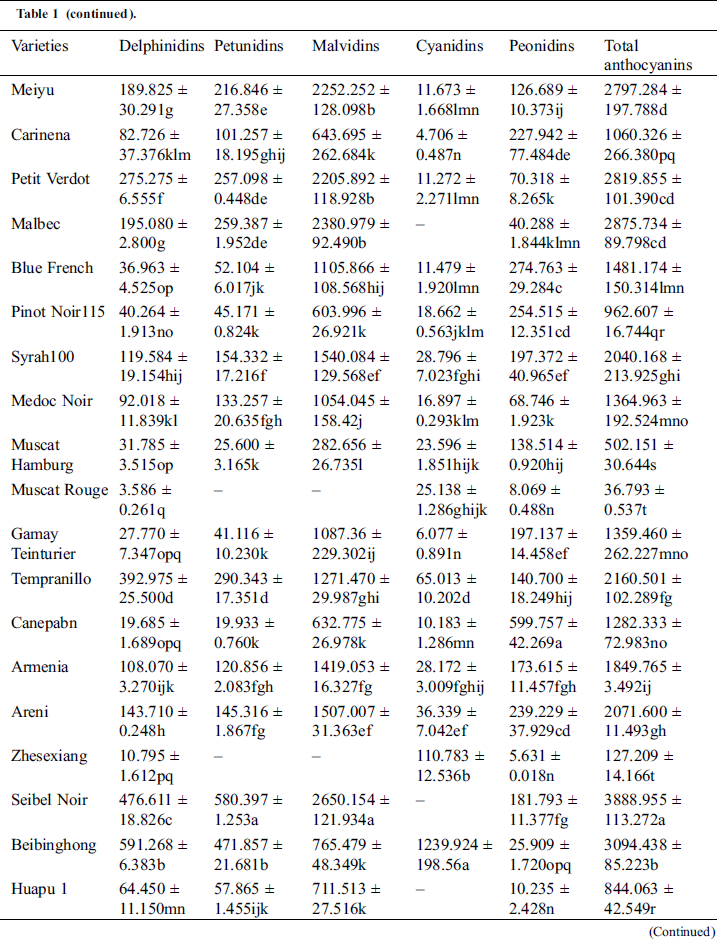
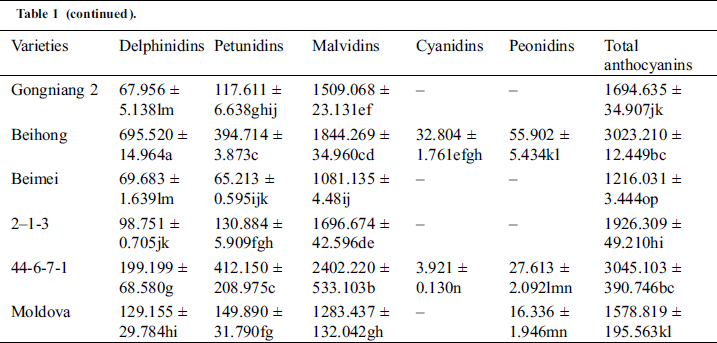
In this study, the anthocyanins were comprised of cyanidin (Cy), delphinidin (Dp), petunidin (Pt), peonidin (Pn) and malvidin (Mv) 3-monoglucosides (or 3,5-diglucosides) along with the corresponding acetyl and p-coumaroyl derivatives in the skins of grape. Pt and Mv were not detected in the skins of ‘Muscat Rouge’ and ‘Zhesexiang’, while in the other 29 varieties, the contents of Mv accounted for 24.7%~89.0% of total anthocyanins, the highest and lowest contents of Mv were observed in ‘Seibel Noir’ and ‘Beibinghong’, respectively (Tab. 1). In ‘Cabernet Franc 327’, ‘Cabernet Sauvignon 169’, ‘Merlot 181’, ‘Ruby Cabernet’, ‘Petit Verdot’, ‘Muscat Hamburg’, ‘Tempranillo’, ‘Bei Binghong’, ‘Huapu 1’, ‘Beihong’ and ‘Beimei’, the contents of Dp were 6.9%~76.2% higher than those of Pt; while in the other 18 varieties, the contents of Pt were 1.1%~73.1% higher than those of Dp. Cy was not detected in the skins of ‘Gongniang 2’, ‘Beimei’, ‘2-1-3’, ‘Marselan c980’, ‘Malbec’, ‘Seibel Noir’, ‘Huapu 1’ and ‘Moldova’, while Pn was not detected in the skins of ‘Gongniang 2’, ‘Beimei’ and ‘2-1-3’. In ‘Muscat Rouge’, ‘Zhesexiang’ and ‘Beibinghong’, the contents of Cy were 3.1, 19.7, and 47.9 times those of Pn, while the contents of Pn in the other 20 varieties were 1.7 to 58.9 times those of Cy (Tab. 1). In ‘Zhesexiang’, ‘Muscat Rouge’ and ‘Beibinghong’, the methylated anthocyanins accounted for only 4.4%, 21.9%, 40.8% of the total anthocyanins, respectively; while in the other 28 varieties, the contents accounted for 75.9%~97.7% of the total anthocyanin contents, which showed that the methylated anthocyanins are the main anthocyanin type (Tab. 2). The highest and lowest proportion was observed in ‘Saperavi’ and ‘Beihong’, respectively.
Table 2: Anthocyanin profiles in grape skins of 31 varieties (mg·kg−1FW)

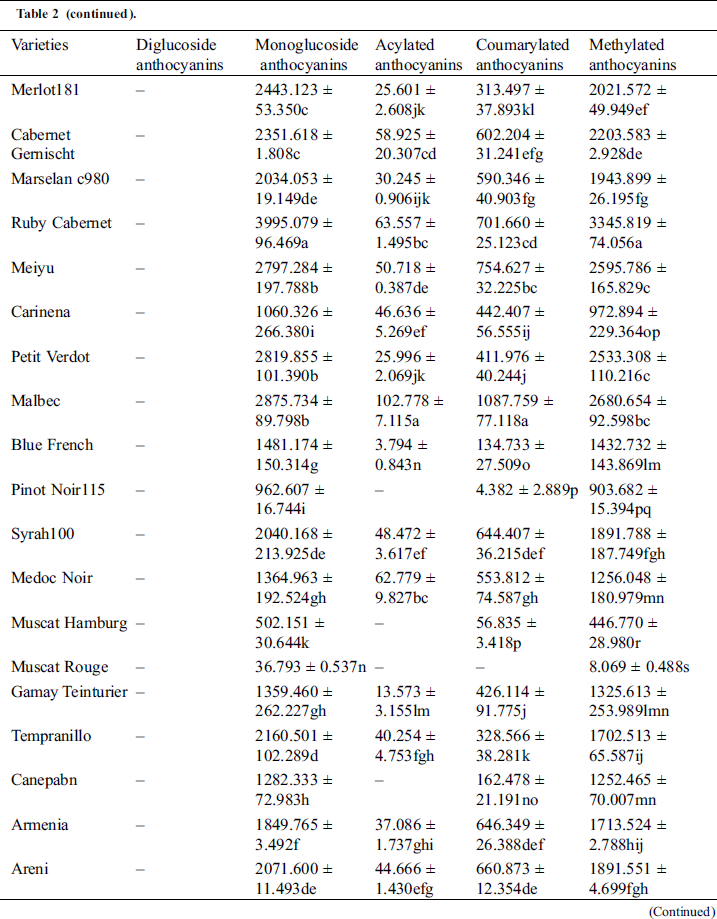
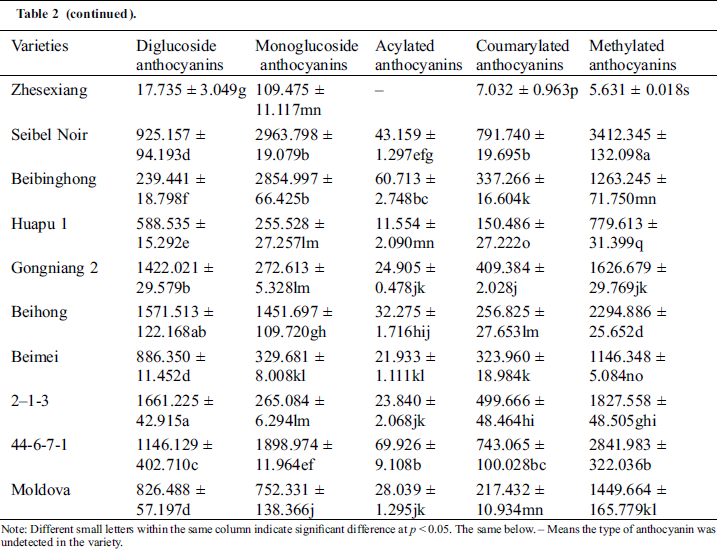
Note: Different small letters within the same column indicate significant difference at p < 0.05. The same below. – Means the type of anthocyanin was undetected in the variety.
As shown in Tab. 2, no 3-p-caffeylated glucoside derivatives were detected in the grape skins. The acetylated glucosides were not detected in ‘Pinot Noir 115’, ‘Muscat Hamburg’, ‘Canepabn’, ‘Muscat Rouge’ and ‘Zhesexiang’; however, in the other 26 grape varieties, the contents accounted for 0.3%~4.6% of the total anthocyanin contents, the lowest and highest proportion were respectively detected in the skins of ‘Blue French’ and ‘Malbec’. Except for ‘Muscat Rouge’, 3-p-coumaroylated glucoside accounted for 0.5% to 41.7% of the total anthocyanin contents in the other 30 varieties; the lowest and highest proportion were observed in ‘Pinot Noir 115’ and ‘Carinena’, respectively. Twenty-one of the V. vinifera varieties have only 3-monoglucoside derivatives of anthocyanins in the skins (Tab. 2), while the contents of 3,5-diglucoside derivatives of anthocyanins in the remaining 10 grape varieties were 17.735~1661.225 mg·kg−1FW, which accounted for 7.7%~86.2% of total anthocyanin contents; the lowest and highest proportion were detected in ‘Beibinghong’ and ‘2-1- 3’ respectively.
3.2 Characteristics of the Anthocyanins in the 21 Eurasian Grape Varieties
As shown in Fig. 1, three to eleven anthocyanin monomers were detected in 21 V. vinifera L varieties. In ‘Muscat Rouge’, there were only three species of anthocyanin monomers detected, including delphinidin 3-O-monoglucoside (M1), cyanidin 3-O-monoglucoside (M2) and petunidin 3-O-monoglucoside (M3); the content of M2 was the highest, which accounted for 68.3% of the total anthocyanin contents. Eleven anthocyanin monomers were detected in ‘Cabernet Franc 327’, ‘Armenia’ and ‘Areni’, including 2 acetylated glucosides, 4 coumaric acylated glucosides and 5 basic mono-glucosides. Ten anthocyanin monomers were detected in ‘Cabernet 169’, ‘Merlot 181’, ‘Tempranillo’, ‘Cabernet Gernischt’, ‘Syrah 100’, ‘Medoc Noir’ and ‘Gamay Teinturier’; 9 anthocyanin monomers were detected in ‘Marselan c980’, ‘Ruby Cabernet’, ‘Petit Verdot’, ‘Mei Yu’, ‘Carinena’ and ‘French Blue’; 8 anthocyanin monomers were detected in ‘Malbec’, ‘Canepabn’ and ‘Muscat Hamburg’; and 5 anthocyanin monomers were detected in ‘Pinot Noir 115’.

Figure 1: The hierarchically clustered heatmap based on the ratios of anthocyanin monomer content to total anthocyanin in 21 grape skins of Vitis vinifera. M1, delphinidin 3-O-monoglucoside; M2, cyanidin 3-O-monoglucoside; M3, petunidin 3-O-monoglucoside; M4, peonidin 3-O-monoglucoside; M5, malvidin-3-O-monoglucoside; M6, delphinidin-3-O-(trans-6-O-coumaroyl)-glucoside; M7, malvidin 3-O-(6-O-acetyl)-glucoside; M8, cyanidin 3-O-(6-O-coumaroyl)-glucoside; M9, petunidin 3-O-(6-O-acetyl)-glucoside; M10, malvidin 3-O-(cis-6-O-coumaroyl)-glucoside; M12, malvidin 3-O-(trans-6-O-coumaroyl)-glucoside
As shown in Fig. 1, the most abundant anthocyanin in ‘Carinena’ and ‘Canepabn’ were malvidin 3-O-(trans-6-O-coumaroyl)-glucoside (M12), which accounted for 37.4% and 57.7% of the total anthocyanin contents, respectively. The second and third abundant anthocyanin in ‘Carinena’ were malvidin-3-O-monoglucoside (M5), and peonidin 3-O-monoglucoside (M4), which respectively accounted for 21.8% and 21.5% of the total anthocyanin contents; while in ‘Canepabn’, M4 and M5 accounted for 22.4% and 17.8% of the total anthocyanin contents, respectively. Except for ‘Muscat Rouge’, ‘Carinena’ and ‘Canepabn’, M5 was the most abundant anthocyanin in the other 18 varieties, which accounted for 40.8%~65.8% of the total anthocyanin contents; the lowest and highest proportion were observed in ‘Medoc Noir’ and ‘Blue French’, respectively. In ‘Cabernet 169’, ‘Tempranillo’ M1 ranked second, which accounted for 11.7%, 15.9% of the total anthocyanin contents, while M3, M12, and M3 ranked third, respectively. In ‘Merlot 181’, ‘Blue French’, ‘Pinot Noir 115’ and ‘Muscat Hamburg’, M4 was the second abundant anthocyanin monomer, while M1, M12, M3 and M12 was the third abundant monomers, respectively. In the other 12 varieties, M12 was the second abundant anthocyanin, which accounted for 13.5%~34.6% of the total anthocyanin contents, the lowest and the highest proportion of M12 was detected in ‘Petit Verdot’ and ‘Medoc Noir’, respectively. M4 was the third abundant anthocyanin in ‘Cabernet Franc327’, ‘Syrah 100’, ‘Gamay Teinturier’, ‘Armenia’ and ‘Areni’, while M3 was the third abundant anthocyanin in ‘Cabernet Gernischt’, ‘Marselan c980’, ‘Meiyu’, ‘Malbec’ and ‘Medoc Noir’. From the above, except for ‘Malbec’, ‘Medoc Noir’, ‘Pinot Noir 115’ and ‘Muscat Rouge’, the main anthocyanins in the other 17 varieties were M1, M3, M4, M5 and M12, which accounted for 91.2%~99.3% of the total anthocyanin contents.
The cluster analysis of anthocyanin monomer characteristics showed that ‘Armenia’ and ‘Areni’ were the most similar among the 21 varieties, followed by ‘Ruby Cabernet’ and ‘Petit Verdot’. The monomer compositions of ‘Cabernet Gernischt’ and ‘Mei Yu’, ‘Merlot 181’ and ‘Tempranillo’ were also relatively similar, but ‘Muscat Rouge’ was very different from the other varieties.
3.3 Characteristics of the Anthocyanins in Ten Hybrid Grape Varieties
The ten hybrid grape varieties included two Vitis vinifera × Vitis labrusca hybrids, three Vitis amurensis Rupr. × Vitis vinifera hybrids, two Vitis vinifera × Vitis amurensis Rupr. hybrids, one Vitis vinifera × Vitis heyneana Roem. et Schult hybrid and two interspecific hybrids. There were five to fifteen anthocyanin monomers detected in the grape skins. As shown in Fig. 2, there were five anthocyanin monomers detected in ‘Zhesexiang’, including four mono-glucoside anthocyanins [M1, M2, M4, and M8 (cyanidin 3-O-(6-O-coumaroyl)-glucoside)] and one di-glucoside anthocyanin (cyanidin 3,5-O-diglucoside, D2); among them, the content of M2 was the highest, which accounted for 67.6% of the total anthocyanin contents. Fifteen kinds of anthocyanin monomers were detected in the grape skins of ‘Seibel Noir’, ‘Beibinghong’ and ‘Beihong’, including 8~9 kinds of mono-glucoside anthocyanins, 6~7 kinds of di-glucoside anthocyanin. Fourteen and thirteen anthocyanin monomers were detected in the grape skins of ‘44-6-7-1’ and its female parent ‘2-1-3’, including 5 and 7 di-glucoside anthocyanins, respectively. Twelve anthocyanin monomers were detected in the grape skins of ‘Huapu 1’ and ‘Gongniang 2’, including 5 or 6 di-glucoside anthocyanins, respectively; while nine anthocyanin monomers were detected in the grape skins of ‘Beimei’ and ‘Moldova’, including 3 and 2 di-glucoside anthocyanins, respectively.

Figure 2: The hierarchically clustered heatmap based on the ratios of anthocyanin monomer content to total anthocyanins in ten grape varieties. M represents the mono-glucoside anthocyanin, D represents the diglucoside anthocyanin; the color scale representing average values is shown on the right side of the figure. M1, delphinidin 3-O-monoglucoside; M2, cyanidin 3-O-monoglucoside; M3, petunidin 3-O-monoglucoside; M4, peonidin 3-O-monoglucoside; M5, malvidin-3-O-monoglucoside; M6, delphinidin-3-O-(trans-6-O-coumaroyl)-glucoside; M8, cyanidin 3-O-(6-O-coumaroyl)-glucoside; M9, petunidin 3-O-(6-O-acetyl)-glucoside; M10, malvidin 3-O-(cis-6-O-coumaroyl)-glucoside; M11, petunidin 3-O-(trans-6-O-coumaroyl)-glucoside; M12, malvidin 3-O-(trans-6-O-coumaroyl)-glucoside; D1, delphinidin 3,5-O-diglucoside; D2, cyanidin 3,5-O-diglucoside; D3, petunidin 3,5-O-diglucoside; D4, peonidin 3,5-O-diglucoside; D5, malvidin 3,5-O-diglucoside; D6, delphinidin 3-O-(6-O-coumaroyl)-glucoside-5-glucoside; D7, petunidin 3-O-(6-O-coumaroyl)-glucoside-5-glucoside; D8, malvidin 3-O-(cis-6-O-coumaroyl)-glucoside-5-glucoside; D9, malvidin-O-(trans-6-O-coumaroyl)-glucoside-5-glucoside
In ‘Zhesexiang’ and ‘Beibinghong’, the most abundant anthocyanin was M2, which accounted for 67.6% and 38.5% of the total anthocyanin contents, respectively, the second abundant anthocyanin was D2 and M5, respectively, which accounted for 13.9% and 18.3%; while M1 ranked third, which accounted for 8.5% and 14.8%, respectively. The top four monomers in ‘Seibel Noir’ were M5, M3, M1, and D9, which accounted for 43.4%, 11.8%, 10.1% and 9.8% of the total anthocyanin contents, respectively. Except for ‘Zhesexiang’, ‘Beibinghong’ and ‘Seibel Noir’, malvidin 3,5-O-diglucoside (D5) was the most abundant anthocyanin in the other seven varieties, which accounted for 30.0%~63.6% of the total anthocyanin contents. The second abundant anthocyanin in ‘Gongniang 2’, ‘Beimei’ and ‘2-1-3’ was malvidin-O-(trans-6-O-coumaroyl)-glucoside-5-glucoside (D9), which accounted for 14.6%, 15.9%, 16.5% of total anthocyanin content, respectively; however, M5 ranked second in ‘Huapu 1’, ‘Moldova’ and ‘44-6-7-1’, which accounted for 11.7%, 21.7%, 27.3% of the total anthocyanin contents. M12 ranked third in ‘Gongniang 2’, ‘2-1-3’ and ‘44-6-7-1’, which accounted for 5.3%, 4.8% and 14.8% of the total anthocyanin contents, respectively; while in ‘Huapu 1’, ‘Beimei’ and ‘Moldova’, D9, M5 and M3 ranked third, respectively. In ‘Beihong’, the monomers ranked second and third were M1 and M5, which accounted for 17.8% and 14.1%, respectively. D5, D9, M5 and M12 were the main anthocyanins in ‘Huapu 1’, ‘Gongniang 2’, ‘Beimei’ and ‘2-1-3’, the total contents of them accounted for 84.3%~88.9% of the total anthocyanin contents; however, in ‘44-6-7-1’ and ‘Moldova’, the main anthocyanins included D5, M5, M12 and M3, which accounted for 82.3% and 83.7% of the total anthocyanin content, respectively.
According to the cluster analysis of anthocyanin monomer characteristics, ‘Gongniang 2’ and ‘2-1-3’ were the closest among the 10 varieties, followed by ‘Huapu 1’ and ‘Beimei’. ‘Zhesexiang’ and ‘Seibel Noir’ were very different from the other varieties.
3.4 Principal Component Analysis of Different Grape Varieties Based on Anthocyanin Content
The principal component analysis (PCA) was carried out based on the ratios of different anthocyanin monomer content to total anthocyanin and the total anthocyanin of 21 Vitis vinifera grape varieties. The first three principal components (PC) accounted for 73.16% of the total variance. PC1, PC2 and PC3 explained 33.56%, 24.17% and 15.43% of the total variance, respectively. Fig. 3 was a scatter plot showing the distribution of 21 grape varieties according to PC1 and PC2. ‘Ruby Cabernet’, ‘Petit Verdot’, ‘Tempranillo’, ‘Merlot 181’, ‘Cabernet Gernischt’, ‘Mei Yu’ and ‘Marselan c980’ lay down on right and upper part of the PC1 axis; ‘Cabernet Sauvignon169’, ‘Cabernet Franc327’, ‘Pinot Noir 115’ and ‘Blue French’ were located on left and upper part of the PC1 axis; ‘Muscat Hamburg’, ‘Gamay Teinturier’, ‘Muscat Rouge’ and ‘Canepabn’ were situated to left and bottom part of the PC1 axis; and the other varieties were located on right and bottom part of the PC1 axis.

Figure 3: Principal component analysis of the anthocyanins in grape skins of 21 grape skins of Vitis vinifera. The analysis was based on the ratios of anthocyanin monomer content to total anthocyanin, and the total anthocyanin. The principal components 1, 2 and 3 explained 33.56%, 24.17% and 15.43% of the total variance, respectively. The principal component 1 and 2 were the horizontal and vertical coordinates, respectively
PCA was also carried out based on the ratios of different anthocyanin monomer content to total anthocyanin and the total anthocyanin of the 10 other grape varieties (Fig. 4). The first three PC accounted for 78.25% of the total variances. PC1, PC2, and PC3 explained 32.75%, 26.31%, and 19.19% of the total variance, respectively. Fig. 4 was a scatter plot showing the distribution of 10 grape varieties according to PC1 and PC2. ‘Seibel Noir’ and ‘44-6-7-1’ were located on right and upper part of the PC1 axis; ‘Beibinghong’, ‘Beihong’ and ‘Zhesexiang’ were located on left and upper part of the PC1 axis; ‘Moldova’ and ‘Huapu 1’ were situated to left and bottom part of the PC1 axis, while ‘Beimei’, ‘2-1-3’ and ‘Gongniang 2’ were situated to right and bottom part of the PC1 axis (Fig. 4).

Figure 4: Principal component analysis of the anthocyanins in grape skins of 10 other grape skins. The analysis was based on the ratios of anthocyanin monomer content to total anthocyanin, and the total anthocyanin. The principal components 1, 2 and 3 explained 32.75%, 26.31%, and 19.19% of the total variance, respectively. The principal component 1 and 2 were the horizontal and vertical coordinates, respectively
3.5 Cluster Analysis of Different Grape Varieties Based on Anthocyanin Content
As shown in Fig. 5A, minimum variance analysis of 21 Vitis vinifera species was carried out according to the ratios of each anthocyanin monomer to total anthocyanin and total anthocyanin content. When the minimum variance was 0.150, the 21 varieties were divided into 3 major groups. Group I consisted of 11 varieties, which were divided into three categories at a variance of 0.050. The first category included ‘Cabernet Franc 327’ and ‘Cabernet Gernischt’; the second category included 7 varieties, ‘Armenia’ and ‘Areni’ were the closest and clustered with ‘Syrah 100’, ‘Marselan c980’ and ‘Meiyu’ was also close; the third category included ‘Carinena’ and ‘Medoc Noir’. Group II included 5 varieties, ‘Cabernet Sauvignon 169’ and ‘Petit Verdot’ clustered first and then clustered with ‘Ruby Cabernet’, ‘Merlot 181’ and ‘Tempranillo’. Group III included 5 varieties, ‘Blue French’ and ‘Pinot Noir 115’ were the closest, they clustered first, and then clustered with ‘Muscat Hamburg’.

Figure 5: The cluster analysis of 31 grape species based on the ratios of each anthocyanin monomer to total anthocyanin and total anthocyanin content. The cluster analysis used the minimum variance method. (A) The cluster analysis of 21 Vitis vinifera species. (B) The cluster analysis of 10 other grape species
As shown in Fig. 5B, when the minimum variance was 0.200, the 10 grape varieties were divided into 3 groups. ‘Zhesexiang’ and ‘Seibel Noir’ were each a group. The third group included eight varieties which divided into three categories at 0.100. The first category included ‘Beibinghong’ and ‘Beihong’; in the second category, ‘Huapu 1’ and ‘Beimei’ were the closest, and they clustered with ‘Moldova’; the third category included ‘Gongniang 2’ and ‘2-1-3’.
The anthocyanins of grapes are mainly found in the skins of colored grape varieties. The composition and contents of anthocyanins vary greatly among different grape varieties [5,8,12]. All anthocyanins are mono-glucoside derivatives in Vitis vinifera [5,19,20], but there are also di-glucoside derivatives in other grape species [21–23]. Sun et al. [18] showed that except for Vitis adenoclada Hand., the main anthocyanins of V. davidii, V. heyneana, V. bryoniaefolia, V. amurensis and V. pseudorticulata are di-glucoside derivatives. However, the proportion of mono-glucoside derivatives in the late mature stage of ‘NW196’ (Vitis quinquangularis × Vitis vinifera) was higher than that of di-glucoside derivatives [24]. In our study, only mono-glucoside derivatives were detected in the 21 Vitis vinifera varieties, while both mono-glucoside and di-glucoside derivatives were detected in the other 10 varieties. Except for ‘Zhesexiang’ ‘Seibel Noir’, ‘44-6-7-1’ and ‘Beibinghong’, in the other six varieties, di-glucoside derivatives accounted for more than 52% of the total anthocyanins, which was consistent with Sun et al. [18].
Many factors can influence the anthocyanin content of grape, such as variety, climate, soil and cultivation methods, and the composition and proportion of anthocyanins in different varieties and even different lines of the same variety are very different [5,22,24,25]; however, they are mainly determined by genetic factors. In this study, the total anthocyanin content in the skins of ‘Ruby Cabernet’ was the highest among the 21 Vitis vinifera grape varieties, followed by ‘Petit Verdot’ and ‘Malbec’. The total anthocyanin content of ‘Syrah 100’ was lower than that of ‘Merlot 181’, ‘Marselan c980’ and ‘Tempranillo’, which was inconsistent with Xing et al. [26]. The content of ‘Cabernet Franc 327’ was lower than that of ‘Merlot 181’, ‘Marselan c980’, ‘Syrah 100’ and ‘Tempranillo’, which was consistent with Xing et al. [26]. The content of ‘Cabernet Sauvignon169’ was lower than that of the interspecific hybrid ‘Moldova’, which was inconsistent with Liu et al. [19]. Differences in climate, soil and cultivation management of the sampling area may result in differences in anthocyanin content.
Studies have found that anthocyanins found in Vitis vinifera L. include malvidin, cyanidin, delphinidin, peonidin and petunidin 3-monoglucosides with their corresponding acetyl, p-coumaric acylated and caffeoyl derivates [5]. In this study, there were 3–11 types of anthocyanins in the 21 Vitis vinifera varieties, including 3-monoglucosides of Cy, Dp, Pn, Pt, Mv, and their acetylated derivatives, p-coumaric acylated derivatives, but no 3-p-caffeylated derivatives, and the contents of anthocyanin monomer varied among varieties. Except for ‘Muscat Rouge’, in the other 20 varieties, the most abundant anthocyanins were malvidin-3-O-monoglucoside (M5) or malvidin 3-O-(trans-6-O-coumaroyl)-glucoside (M12), which was consistent with the literature [20,26]. According to the cluster analysis, ‘Armenia’ and ‘Areni’ were the closest, which because the two grapes are the same variety but have different names [27]. ‘Cabernet Franc 327’ and ‘Cabernet Gernischt’ were close to each other and were grouped with ‘Marselan c980’, ‘Mei Yu’, ‘Gamay Teinturier’, ‘Malbec’ and ‘Syrah 100’. After ‘Cabernet Sauvignon 169’, ‘Petit Verdot’ and ‘Ruby Cabernet’ clustered, they were combined with ‘Merlot 181’ and ‘Tempranillo’. ‘Cabernet Franc’ is the mother of ‘Merlot’ and the father of ‘Cabernet Sauvignon 169’, ‘Cabernet Gernischt’; ‘Cabernet Sauvignon’ is the mother of ‘Marselan’ and the father of ‘Ruby Cabernet’. There are parent-child relationships in all six varieties. The heritability of the parents may affect the clustering of anthocyanin contents.
A total of 5 to 15 anthocyanin monomers were detected in the skins of 10 hybrid grape varieties, all varieties contained di-glucoside anthocyanins. The most abundant monomer in ‘Zhesexiang’ and ‘Beibinghong’ was M2, while the ones in ‘Seibel Noir’ and other 7 varieties was M11 and D5, respectively. The anthocyanin ‘Moldova’ were consistent with Liu et al. [19], while the results for ‘2-1-3’ (Vitis quinquangularis × Vitis vinifera) were inconsistent with the study of ‘NW196’ [25]. From the cluster analysis, ‘Beihong’ and ‘Beibinghong’ were relatively closer and clustered into one category, while ‘Huapu 1’, ‘Beimei’, ‘Moldova’ and ‘44-6-7-1’ were clustered into one large category, ‘2-1-3’ and ‘Gongniang 2’ were close. ‘Huapu 1’, ‘Beimei’, ‘Beihong’, ‘Beibinghong’ and ‘Gongniang 2’ were all the hybrid offspring of Vitis amurensis R and Vitis vinifera, while ‘2-1-3’ is the female parent of ‘44-6-7-1’; thus, the genetic relationship may affect the anthocyanin content.
There were significant differences in the anthocyanin types and contents of the skins between V. vinifera and other grapes. In V. vinifera, all anthocyanins were mono-glucoside derivatives, but in the other Vitis germplasms, there are also di-glucoside derivatives. There were 21 anthocyanins in the grape skins. Mv-derivatives were the most abundant anthocyanins in V. vinifera and eight other grapes with a high content. The most abundant anthocyanins in different varieties may be different. Anthocyanins can be used as chemical fingerprints to distinguish wine grape varieties.
Funding Statement: This work was financially supported by China Natural Science Foundation of Shandong Province (ZR2019BC092), Doctoral Research Fundation of Zaozhuang University (1020707), Shanxi Provincial Key Research and Development Project (201603D21105).
Conflicts of Interest: The authors declare that they have no conflicts of interest to report regarding the present study.
1. Fernandes, A., Brandão, E., Raposo, F., Maricato, É. Oliveira, J. et al. (2020). Impact of grape pectic polysaccharides on anthocyanins thermostability. Carbohydrate Polymers, 239, 116240. DOI 10.1016/j.carbpol.2020.116240. [Google Scholar] [CrossRef]
2. Silva, V. O., Freitas, A. A., Macanita, A. L., Quina, F. H. (2016). Chemistry and photochemistry of natural plant pigments: The anthocyanins. Journal of Physical Organic Chemistry, 29(11), 594–599. DOI 10.1002/poc.3534. [Google Scholar] [CrossRef]
3. OIV. (2019). OIV, 2019 report on the world vitivinicultural situation. http://www.oiv.int. [Google Scholar]
4. Busse-Valverde, N., Gómez-Plaza, E., López-Roc, J. M., Gil-Muňoz, R., Bautista-Ortín, A. B. (2011). The extraction of anthocyanins and proanthocyanidins from grapes to wine during fermentative maceration is affected by the enological technique. Journal of Agricultural and Food Chemistry, 59(10), 5450–5455. DOI 10.1021/jf2002188. [Google Scholar] [CrossRef]
5. Liang, Z., Wu, B., Fan, P., Yang, C., Duan, W. et al. (2008). Anthocyanin composition and content in grape berry skin in Vitis germplasm. Food Chemistry, 111(4), 837–844. DOI 10.1016/j.foodchem.2008.04.069. [Google Scholar] [CrossRef]
6. Oliveira, H., Perez-Gregório, R., de Freitas, V.,Mateus, N., Fernandes, I. (2019). Comparison of the in vitro gastrointestinal bioavailability of acylated and non-acylated anthocyanins: Purple-fleshed sweet potato vs. red wine. Food Chemistry, 276, 410–418. DOI 10.1016/j.foodchem.2018.09.159. [Google Scholar] [CrossRef]
7. Sun, X., Cheng, X., Zhang, J., Ju, Y., Que, Z. et al. (2020). Letting wine polyphenols functional: Estimation of wine polyphenols bioaccessibility under different drinking amount and drinking patterns. Food Research International, 127, 108704. DOI 10.1016/j.foodres.2019.108704. [Google Scholar] [CrossRef]
8. Budić-Leto, I., Mucalo, A., Ljubenkov, I., Zdunić, G. (2018). Anthocyanin profile of wild grape Vitis vinifera in the eastern Adriatic region. Scientia Horticulturae, 238, 32–37. DOI 10.1016/j.scienta.2018.04.036. [Google Scholar] [CrossRef]
9. Fraige, K., Pereira-Filho, E. R., Carrilho, E. (2014). Fingerprinting of anthocyanins from grapes produced in Brazil using HPLC–DAD–MS and exploratory analysis by principal component analysis. Food Chemistry, 145, 395–403. DOI 10.1016/j.foodchem.2013.08.066. [Google Scholar] [CrossRef]
10. Zou, L. M., Zhong, G. Y., Wu, B. H., Yang, Y. Z., Li, S. H. et al. (2019). Effects of sunlight on anthocyanin accumulation and associated co-expression gene networks in developing grape berries. Environmental and Experimental Botany, 166, 103811. DOI 10.1016/j.envexpbot.2019.103811. [Google Scholar] [CrossRef]
11. Yang, B. H., He, S., Liu, Y., Liu, B. C., Ju, Y. L. et al. (2020). Transcriptomics integrated with metabolomics reveals the effect of regulated deficit irrigation on anthocyanin biosynthesis in Cabernet Sauvignon grape berries. Food Chemistry, 314, 126170. DOI 10.1016/j.foodchem.2020.126170. [Google Scholar] [CrossRef]
12. Figueiredo-González, M., Martínez-Carballo, E., Cancho-Grande, B., Santiago, J. L., Martínez, M. C. et al. (2012). Pattern recognition of three Vitis vinifera L. red grapes varieties based on anthocyanin and flavonol profiles, with correlations between their biosynthesis pathways. Food Chemistry, 130(1), 9–19. DOI 10.1016/j.foodchem.2011.06.006. [Google Scholar] [CrossRef]
13. Nogales-Bueno, J., Rodriguez-Pulido, F. J., Heredia, F. J., Hernandez-Hierro, J. M. (2015). Comparative study on the use of anthocyanin profile, color image analysis and near-infrared hyperspectral imaging as tools to discriminate between four autochthonous red grape cultivars from La Rioja (Spain). Talanta, 131, 412–416. DOI 10.1016/j.talanta.2014.07.086. [Google Scholar] [CrossRef]
14. Pisano, P. L., Silva, M. F., Olivieri, A. C. (2015). Anthocyanins as markers for the classification of Argentinean wines according to botanical and geographical origin. Chemometric modeling of liquid chromatography–mass spectrometry data. Food Chemistry, 175, 174–180. DOI 10.1016/j.foodchem.2014.11.124. [Google Scholar] [CrossRef]
15. Budić-Leto, I., Mucalo, A., Ljubenkov, I., Zdunić, G. (2018). Anthocyanin profile of wild grape Vitis vinifera in the eastern Adriatic region. Scientia Horticulturae, 238, 32–37. DOI 10.1016/j.scienta.2018.04.036. [Google Scholar] [CrossRef]
16. Costa, E., Cosme, F., Jordão, A. M., Mendes-Faia, A. (2014). Anthocyanin profile and antioxidant activity from 24 grape varieties cultivated in two Portuguese wine regions. Journal International Des Sciences De La Vigne Et Du Vin, 48, 51–62. [Google Scholar]
17. Wang, H., Race, E. J., Shrikhande, A. J. (2003). Characterization of anthocyanins in grape juices by ion trap liquid chromatography-mass spectrometry. Journal of Agricultural and Food Chemistry, 51(7), 1839–1844. DOI 10.1021/jf0260747. [Google Scholar] [CrossRef]
18. Sun, L., Fan, X. C., Zhang, Y., Jiang, J. F., Sun, H. S. et al. (2015). Analysis of anthocyanin composition in berry skin of Chinese wild grape. Journal of Fruit Science, 32(6), 1143–1151. [Google Scholar]
19. Liu, X. H., Guo, S. H., Niu, Y. J., Du, Y. P., Zhai, H. (2017). Analysis of anthocyanin compositions and contents in eight grape cultivars. Journal of Fruit Science, 34(4), 444–453. [Google Scholar]
20. Nuñez, V., Monagas, M., Gomez-Cordoves, M. C., Bartolomé, B. (2004). Vitis vinifera L.cv. Graciano grapes characterized by its anthocyanin profile. Postharvest Biology and Technology, 31(1), 69–79. DOI 10.1016/S0925-5214(03)00140-6. [Google Scholar] [CrossRef]
21. Bakker, J., Timberlake, C. F. (1997). Isolation, identification, and characterization of new color-stable anthocyanins accuring in some red wines. Journal of Agricultural and Food Chemistry, 45(1), 35–43. DOI 10.1021/jf960252c. [Google Scholar] [CrossRef]
22. Wang, H., Race, E. J., Shrikhande, A. J. (2003). Characterization of anthocyanins in grape juices by ion trap liquid chromatography-mass spectrometry. Journal of Agricultural and Food Chemistry, 51(7), 1839–1844. DOI 10.1021/jf0260747. [Google Scholar] [CrossRef]
23. Tsanova-Savova, S., Dimov, S., Ribarova, F. (2002). Anthocyanins and color variables of Bulgarian aged red wines. Journal of Food Composition and Analysis, 15(6), 647–654. DOI 10.1006/jfca.2002.1100. [Google Scholar] [CrossRef]
24. Cheng, G., Zhou, S. H., Zhang, J., Zhang, Y., Guan, J. X. et al. (2017). Analysis of anthocyanin composition and genes expression patterns of Vitis quinquangularis × V. vinifera ‘NW196’. Acta Horticulture Sinica, 44(6), 1073–1084. [Google Scholar]
25. Muñoz, C., Gomez-Talquenca, S., Chialva, C., Ibáñez, J., Martinez-Zapater, J. M. et al. (2014). Relationships among gene expression and anthocyanin composition of Malbec grapevine clones. Journal of Agricultural and Food Chemistry, 62(28), 6716–6725. DOI 10.1021/jf501575m. [Google Scholar] [CrossRef]
26. Xing, T. T., Yang, H. Y., Wang, W. R., Yang, X. H., Wang, J. (2018). The compositions and contents of anthocyanins in 14 Vitis vinifera red wine grape varieties or clones. Journal of Fruit Science, 35(2), 147–157. [Google Scholar]
27. Tan, W., Zhao, Q. F., Li, Q. L. (2019). Genetic Relationship of 29 red wine grape varieties revealed by simple sequence repeat markers in skins. Northern Horticulture, 17, 41–49. [Google Scholar]
Appendix
Supplementary Table 1: List of 31 grapevine varieties and collected date
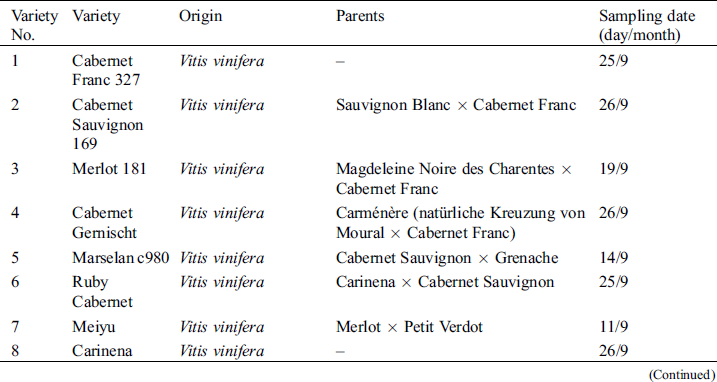
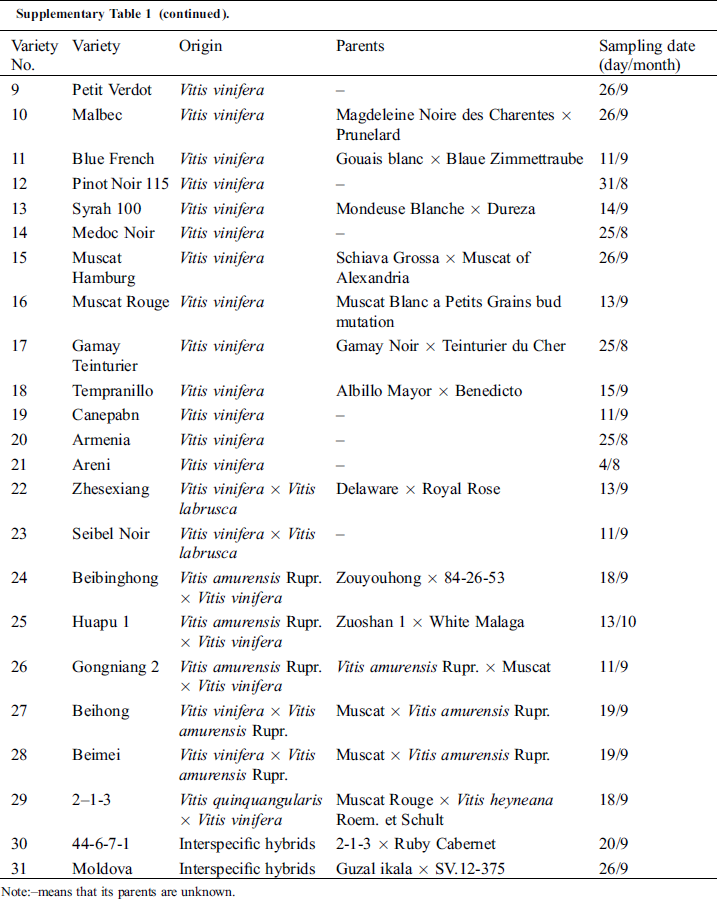
Note:–means that its parents are unknown.
Supplementary Table 2: Molecular and fragmentation ions of anthocyanins in grapes as determined using HPLC-MS

 | This work is licensed under a Creative Commons Attribution 4.0 International License, which permits unrestricted use, distribution, and reproduction in any medium, provided the original work is properly cited. |